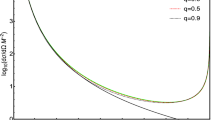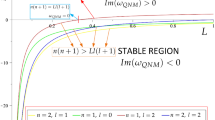Abstract
We study radiation of scalar particles from charged dilaton black holes. The Hamilton–Jacobi method has been used to work out the tunneling probability of outgoing particles from the event horizon of dilaton black holes. For this purpose we use WKB approximation to solve the charged Klein–Gordon equation. The procedure gives Hawking temperature for these black holes as well.
Similar content being viewed by others
Avoid common mistakes on your manuscript.
Quantum mechanical effects combined with gravity theories present a picture of black holes that emit radiations and can evaporate [1, 2]. Different techniques have been developed to study these radiations from a variety of black configurations [3–18]. Four- and five-dimensional dilaton black holes have also been studied for Hawking radiations using different techniques [19–22]. In this paper we study emission of scalar particles from charged dilaton black holes. For this purpose we use the Hamilton–Jacobi method and apply WKB approximation to the Klein–Gordon equation to calculate the imaginary part of the classical action for outgoing trajectories across the horizon. WKB approximation has widely been used to calculate the tunneling probability of particles and Hawking temperature of black holes. This approximation is valid in the range where the size of the particle is much smaller than that of the black hole and thus can be treated as point-like. After working out the tunneling probability for the classically forbidden trajectory, we compare this with the Boltzmann factor \(\Gamma =\exp \left( -\beta E\right)\), for particle of energy \(E\). We obtain Hawking temperature for the black hole also, as \(\beta \) is the inverse of the horizon temperature [6, 7].
Dilaton black hole is a solution of Einstein’s field equations in which charged dilaton field is coupled with the Maxwell field. Dilaton is a scalar field, which occurs in low energy limit of the string theory in which the fields like axion and dilaton are incorporated in Einstein’s action. The four dimensional Langragian in low energy is given by [19, 22]
where \(a\), the coupling parameter, denotes the strength of the coupling of the dilaton field \(\Phi \) to the Maxwell field \(F,\, g\) is the determinant of the metric tensor \(g_{\mu \nu }\) and \(R\) is the Ricci scalar. The line element for charged and spherically symmetric dilaton black hole is given by [19, 22]
where
Here, \(\Phi \) and \(F\) are given as
The ADM mass \(M\) and electric charge \(Q\) of the dilaton black hole are given by
The outer and inner horizons, \(r_{+}\) and \(r_{-}\), of the dilaton black hole are given by
Here \(a\) is confined in the interval \(0\le a\le 1\). When \(a=0\), the metric reduces to the Reissner–Nordström solution. The electric potential of the dilatonic black hole is given as
To deal with scalar tunneling we use the charged Klein–Gordon equation for scalar field, \(\Psi =\Psi \left( t,r,\theta ,\phi \right)\), given by
where \(q\) and \(m\) are the charge and mass of the scalar particle and \(\hbar \) is Planck’s constant. To apply WKB approximation in lowest order we choose the scalar field of the form
Here \(I\) is the action for the outgoing trajectory. Substituting Eq. (12) in (11) in the lowest order in \(\hslash \), dividing by the exponential term and multiplying by \(\hslash ^{2}\), yields
We note that \(\partial _{t}\) and \(\partial _{\phi }\) are the only Killing fields for the spacetime at hand (Eq. (2)). So we can assume the following separation of variables for the action
where \(E,\, J\) and \(K\) are constants; \(E\) and \(J\) represent the energy and the angular momentum of the emitted particle and \(K\) can be complex also. It is pertinent to mention here that we are only considering radial trajectories. This is because in the tunneling approach of Hawking radiation the particles are locally considered to follow \(\theta =\) constant geodesics. Further, in the case of spin-1/2 particles (like fermions) we deal with spin-up and spin-down cases separately and correspondingly get two equations (see, for example, Refs. [11, 16, 17]). For scalars this is not the case and we have only one equation. Using Eq. (14) in Eq. (13), and solving for \(W\left( r,\theta \right)\) for \(\theta =\theta _{\circ }\), gives
With the obvious substitution we can write the above integral as
Thus we have a simple pole at \(r=r_+\). We evaluate this integral around the pole at the outer horizon by using the residue theory for semi circles. This yields
Here ‘\(+\)’ and ‘\(-\)’ represent the outgoing and incoming trajectories, respectively. The above equations implies that
The tunneling probabilities of crossing the horizon from inside to outside and outside to inside are given by [6, 7]
An incoming particle will definitely cross the horizon and fall into the black hole, therefore, to normalize the probability of the incoming particle we must have
in Eqs. (18) and (19). From Eq. (16) we note that
This means that the probability of a particle tunneling from inside to outside the horizon is given by
By putting the value of \(Im W_{+}\) from Eq. (17) into Eq. (22), the tunneling probability comes out to be
By comparing with the Boltzmann factor this gives us Hawking temperature as
where \(r_{+}\) and \(r_{-}\) are the outer and inner horizons of the black hole. This formula is consistent with the previous literature [19, 20].
References
Hawking, S.W.: Particle creation by black holes. Commun. Math. Phys. 43, 199 (1975)
Hawking, S.W.: Black hole explosions? Nature 248, 30 (1974)
Gibbons, G.W., Hawking, S.W.: Cosmological event horizons, thermodynamics, and particle creation. Phys. Rev. D 15, 2738 (1977)
Iso, S., Umetsu, H., Wilczek, F.: Anomalies, Hawking radiations and regularity in rotating black holes. Phys. Rev. D 74, 044017 (2006)
Parikh, M.K., Wilczek, F.: Hawking radiation as tunnelling. Phys. Rev. Lett. 85, 5042 (2000)
Srinivasan, K., Padmanabhan, T.: Particle production and complex path analysis. Phys. Rev. D 60, 24007 (1999)
Shankaranarayanan, S., Padmanabhan, T., Srinivasan, K.: Hawking radiation in different coordinate settings: complex paths approach. Class. Quantum Grav. 19, 2671 (2002)
Akhmedova, V., Pilling, T., de Gill, A., Singleton, D.: Temporal contribution to gravitational WKB-like calculations. Phys. Lett. B 666, 269 (2008)
Akhmedov, E.T., Akhmedova, V., Singleton, D.: Hawking temperature in the tunneling picture. Phys. Lett. B 642, 124 (2006)
Kerner, R., Mann, R.B.: Tunnelling, temperature and Taub-NUT black holes. Phys. Rev. D 73, 104010 (2006)
Kerner, R., Mann, R.B.: Charged Fermions tunnelling from Kerr-Newman black holes. Phys. Lett. B 665, 277 (2008)
Vagenas, E.C., Das, S.: Gravitational anomalies, Hawking radiation, and spherically symmetric black holes. JHEP 10, 025 (2006)
Yale, A.: Exact Hawking radiation of scalars, fermions, and bosons using the tunneling method without back-reaction. Phys. Lett. B 697, 398 (2011)
Ding, C., Jing, J.: Deformation of contour and Hawking temperature. Class. Quantum Grav. 27, 035004 (2010)
Gillani, U.A., Rehman, M., Saifullah, K.: Hawking radiation of scalar partcles from accelerating and rotating black holes. JCAP 06, 016 (2011)
Gillani, U.A., Saifullah, K.: Tunneling of Dirac particles from accelerating and rotating Black holes. Phys. Lett. B 699, 15 (2011)
Ahmed, J., Saifullah, K.: Hawking temperature of rotating charged black strings from tunneling. JCAP 11, 023 (2011)
Gohar, H., Saifullah, K.: Emission of scalar particles from cylindrical black holes. arXiv:1109.5836
Liu, C.Z., Zhang, J.Y., Zhao, Z.: Charged particle’s tunneling from a dilaton black hole. Phy. Lett. B 639, 670 (2006)
Chen, D.Y., Jiang, Q.Q., Zu, X.T.: Fermions tunnelling from the charged dilatonic black holes. Class. Quantum Grav. 25, 205022 (2008)
Becar, R., González, P.A.: Hawking radiation for scalar and Dirac fields in five dimensional dilatonic black hole via anomalies. arXiv:1104.0356
Gibbons, G.W., Maeda, K.: Black holes and membranes in higher dimensional theories with dilaton fields. Nucl. Phys. B 298, 741 (1988)
Acknowledgments
We are thankful for the referee’s comments which helped us improve our manuscript.
Author information
Authors and Affiliations
Corresponding author
Rights and permissions
About this article
Cite this article
Gohar, H., Saifullah, K. Scalar field radiation from dilatonic black holes. Gen Relativ Gravit 44, 3163–3167 (2012). https://doi.org/10.1007/s10714-012-1449-x
Received:
Accepted:
Published:
Issue Date:
DOI: https://doi.org/10.1007/s10714-012-1449-x




